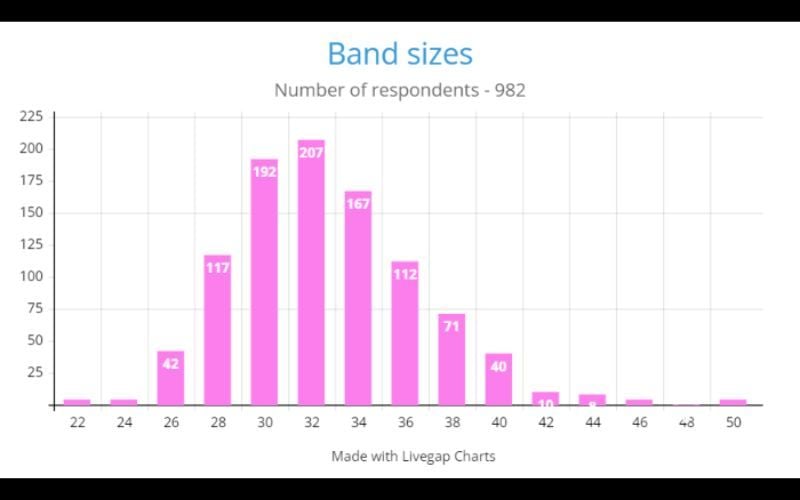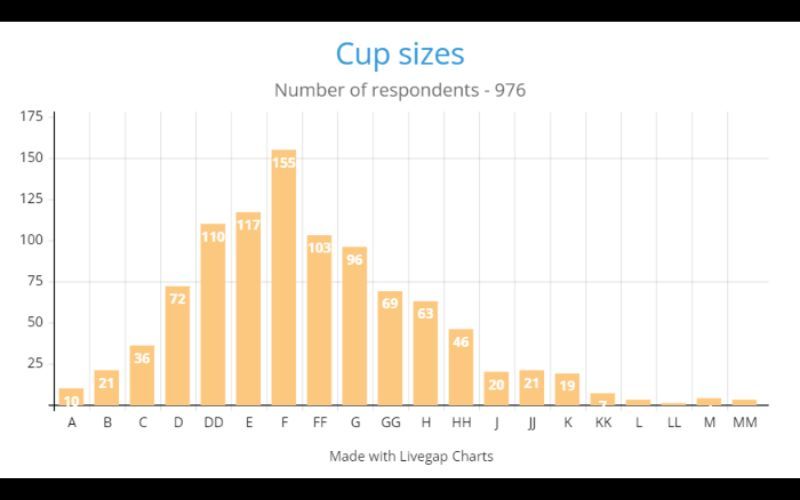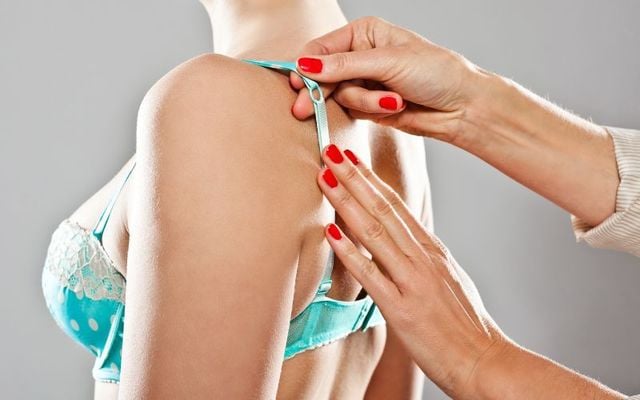In the past year or so, I started following @TheIrishBraLady on Instagram.
I can't quite remember how I stumbled upon her page (which boasts more than 17,300 followers) but her bio was intriguing: "Think DD cups are large? You have a LOT to learn about bra sizing!
"Find bras uncomfortable? You're probably wearing the wrong size. I am here to help!"
I reached out to the Irish Bra Lady - who wants to keep her real identity anonymous - to find out more about her mission.
Here's what she told me ...
I must be a 32A
So I'm an Irish girl in my mid-twenties. I wore a 32A bra size pretty much all my life because I figured, I have small boobs and I'm slim, so if 32 is the smallest band size I can find, and A is the smallest cup size, I must be a 32A.
Somewhere along the line, I was fitted in a 30B in Victoria's Secret and I thought this was the correct size for a long time, but it still wasn't.
A fitting in Ann Summers confirmed that I might be even smaller than a 30B, a 28 band perhaps, and in my head I scoffed at this - I thought 'Well, those don't exist, so I couldn't be that because my frame isn't abnormal, I know lots of people like me.'
View this post on Instagram
Fed up
Fast forward another couple of years and I stumbled upon the A Bra That Fits calculator when I was fed up with buying another bunch of bras that didn't fit quite right.
26E was the result it provided and if I had been drinking something I'd have spat that out. I couldn't fathom being a 26 band because nobody sells those, so how could I have a rare band size when I have no problem finding clothes that fit?
I also couldn't fathom the E cup size because, um, those are huge right?
I couldn't have been more wrong and after making a few posts in the A Bra That Fits subreddit saying things like 'I think I did something wrong', that's where my bra size learning journey started.
Navigating bra fitting with confidence
About a year after all that, I started @TheIrishBraLady because I was appalled at the amount of misconceptions, misinformation, and downright scamming going on in the industry and I want to give people the knowledge and skills to be able to navigate their own bra fitting journey with confidence. Although that's just the start of it.
Another huge reason why I started the page is because many very common sizes are very difficult to find in stores, and the sizes stores are actually selling aren't reflective of the sizes we need.
Think of sizes like 32A, 34A, 32B, 34B, 32C, and 34C - these can be bought basically anywhere and within any price range, you can find them cheap, expensive, or in between.
Now think of sizes like 26F, 28DD, 28F, 30E, 30F, 30FF, 32FF, 32G, 34G - hard to find right? Yet these are some of the most common sizes - people just don't know it.
View this post on Instagram
It's like me - I see that most stores carry cup sizes A-DD and band sizes 32-38. Being slim and small-boobed, I assume I must be a 32A. That's what's happening to people. They assume the common size matrix sold in stores matches the common sizes people need (and how can you blame them, it should) and they assume that they fit in there somewhere.
So, people are going to the trouble of finding their true sizes and being happy with this, only to realize that their true size actually can't be purchased in-store, only online, and usually for a very high price, and hey, no refunds either if the shape isn't quite right. So this is a huge part of the reason I do what I do.
We need basically the majority of the world to know their correct size if we want any changes to happen in the industry.
The size range carried in stores is one of the big reasons why so many of us wear the wrong size, but there's also being incorrectly fitted. So many places fit incorrectly. Victoria's Secret, Ann Summers, Debenhams, Marks and Spencers, the list goes on - and these are places that I often see recommended! Even some independent bra boutiques fit incorrectly. That's why I think it's important for people to learn how to measure themselves and find their own bra size, it's honestly really easy and not something that you need a degree of any sort for.
The hardest part is finding bras that suit your breast shape, because even within bras of the same size, there is variation, like anything in clothing. Finding the right size is the first step and that is absolutely something you can do yourself.
The best part is, you can trust yourself. You don't have to worry about someone putting you in the wrong size to make a sale. You aren't going to scam yourself.
Another reason why so many people are wearing the wrong size is the +4 method. Have you ever heard of measuring your band size and adding 4/5 inches depending on whether you get an even or odd measurement? That's the +4 method and it's incorrect yet still widely used. I have seen NEW brands use it still to this day. Whatever your snug underbust measurement is, that's your band size, unless it's odd in which case you can round up to the nearest even number so 25 is 26, 27 is 28, 33 is 34, and so on. But adding inches, is one of the worst things you can do! And it's used so much.

Surveying more than 900 people, the Irish Bra Lady found that the most common band size was 32. (Credit: The Irish Bra Lady)
Misconceptions
There are general societal misconceptions and bra size fitting misconceptions.
People tend to think A = very small, B = small, C = medium, D = large, DD = very large, and anything over DD is huge. This couldn't be more wrong!
A recent survey I did with my followers showed D, DD, E, F, FF, and G to be the most common range that people fell into, and A, B, and C being as uncommon as JJ, K, and KK:

Surveying more than 900 people, the Irish Bra Lady found that F was the most common cup size. (Credit: The Irish Bra Lady)
Gaps in your cups mean you need a smaller cup size
Nope! They can often mean you need a bigger cup size.
A too-tight band means you need to go up a band size
Nope! This can often mean you need to go down a band size.
Also - you can't judge your band's fit by just wearing the bra normally, because the cups and straps will interfere and make you misjudge the band fit. You need to judge the fit of the band independently from the cups and straps, so you need to basically put it on upside-down around your underbust (on the loosest clasp, always on the loosest clasp, you are only meant to use the tighter clasps as the band stretches out over time) with the cups facing down towards your bellybutton and then you can judge the fit. A lot of people are shocked by how this changes things, a band that felt like it was suffocating them when wearing it properly can actually feel fine on its own, showing that the cups were the problem and the band actually might even be too loose! If you can pull it more than an inch away from your body when wearing it upside-down like this, it's too loose and is providing no support.
The cups and straps provide the most support
Nope! The band provides the majority of support, that's why it needs to be snug. The cups and straps help, but the band does the most. That's how strapless bras work so if yours is falling down, the cups are likely too small and the band likely too big!
Who knew?! You can follow @TheIrishBraLady on Instagram to start learning more about how to properly size yourself for a bra.




Comments